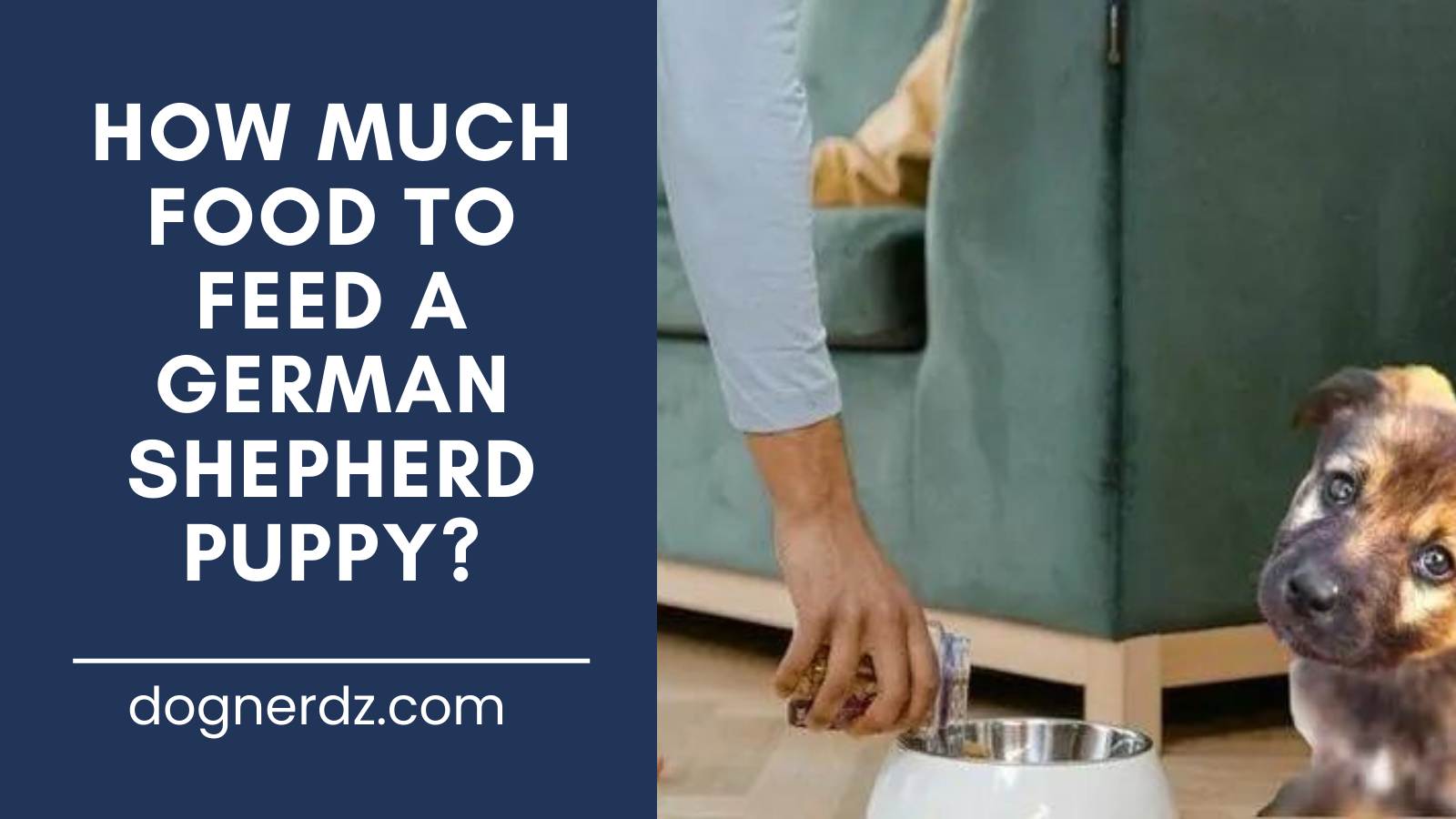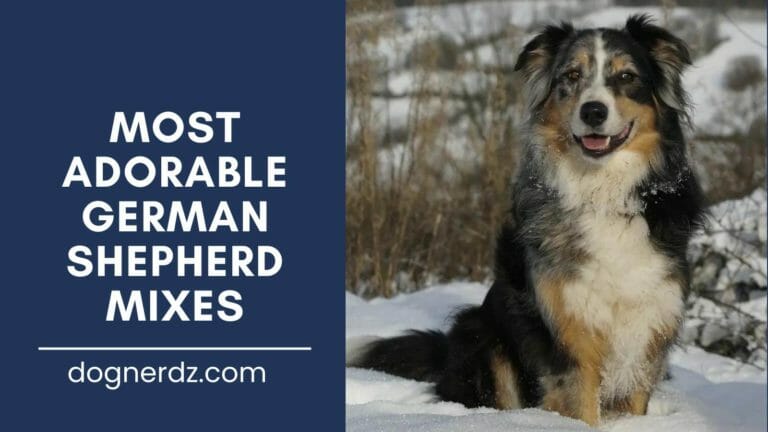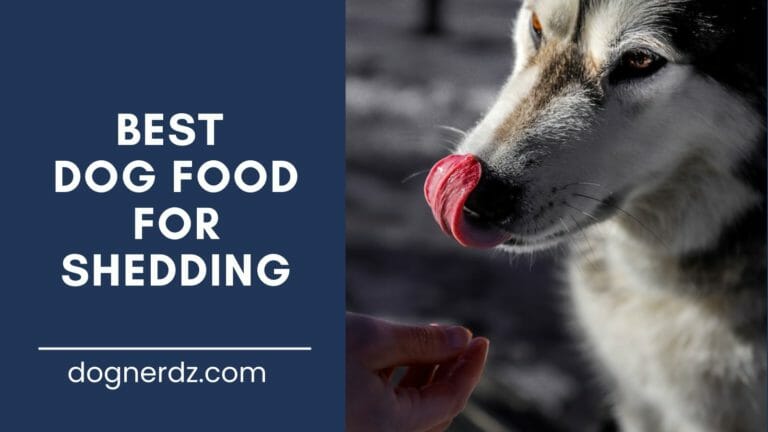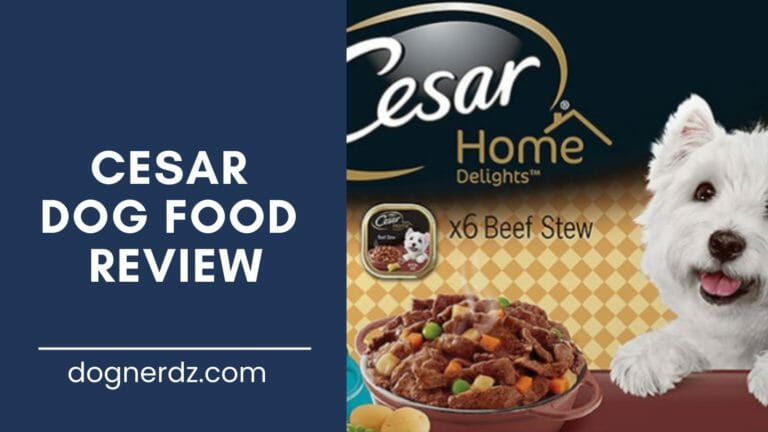How Much Food to Feed a German Shepherd Puppy?
Table of Contents
German Shepherds are giants, with some tipping the scales near 100 pounds! Typically, the heftier the hound, the hungrier they are, puppies included. A German Shepherd whelp chomps down more grub than tiny tail-waggers like a Shih-Tzu youngster, but how do we hit the mark between ‘just right’ and ‘oops, too much’? Well, that’s our adventure today.
Adequate nutrition for a German Shepherd puppy is one of the key components to a healthy and thriving canine in adulthood. Too little can result in malnutrition and too much could lead to obesity – both of which are not ideal for German Shepherd puppies.
How Much Does a German Shepherd Puppy Eat?
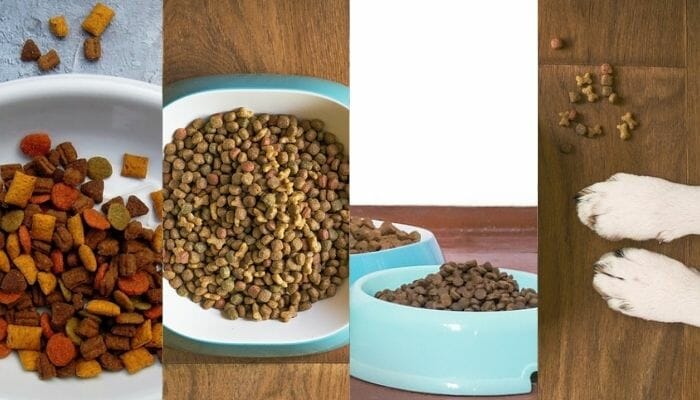
We can only give a generalization in this section because how much to feed a German Shepherd puppy will depend on a variety of factors, which we will get into in a bit. A German Shepherd feeding guide is meant to be used as a guideline and it doesn’t always have to be followed to the letter because all large breed puppies grow at varying rates and have different exercise levels.
At 2 months of age, a German Shepherd puppy will need around 1 to 1.5 cups of food.
The amount you feed a German Shepherd puppy will increase even by a single month. Add 0.5 cups to the amount when your pup reaches 3 months, so it will be 1.5 to 2 cups depending on how much you initially started out with.
You can stay at 1.5 to 2 cups until your German Shepherd puppy reaches 6 months. By this tie, you should increase his puppy food to 2 to 3 cups.
Maintain this amount until your pup reaches 12 months or a year old, which is when he nears his full size. This is when the amount increases to 3 to 3.5 cups and is also around the same time your German Shepherd puppies should switch to adult dog food. Remember that these are all guidelines, and a very active and slightly larger pup should eat more than one that’s smaller and not as rambunctious.
German Shepherd Puppy Diets

Congratulations on welcoming a loyal, courageous, and very loving German Shepherd puppy into your family! Understanding the type of diet to feed your pup can help reduce medical bills in adult dogs. There are various types of diet that you can opt for, from the trendy BARF diet, to regular kibble, how do you assess which is best? To help you find the right puppy food, we will dive into detail about the benefits of each type.
Feeding a German Shepherd Puppy Kibble
Kibble, also referred to as dry puppy food or dry food in general, is created to provide well-balanced nourishment for your dog at any life stage. When you head to the pet store, you will notice more selections of dry puppy food than anything else, and there is a reason for this. First of all, dry commercial dog foods are usually cheaper than the rest, and keeps for much longer.
We say it’s usually cheaper because top-quality dry dog food can still be quite expensive. Dry kibble is made up of pellets, and the sizes can vary. There are dry dog food options for large breeds like German Shepherds that see larger pieces, while kibble for small to toy breeds are noticeably smaller. The logic behind this is simple – the smaller the mouth, the smaller the pieces.
Dry dog food is great for dogs for another reason – they help promote dental hygiene. How does it do this? Dry puppy food is hard, which will scrape against the sides of your pup’s teeth to remove plaque and tartar and prevent buildup. You should be careful when feeding your German Shepherd pup any type of food. Read the label to make sure you’re giving him the best.
Since kibble puppy food is dry, dog owners should make water easily accessible since your GSD puppy will be very thirsty.
Feeding a German Shepherd Puppy Wet Dog Food
Another option for a German Shepherd pup is wet food, or canned food, or ones that come in a pouch. Wet food also makes great food toppers, as many owners use a scoop or two to top off dry food for picky eaters. Wet food can also be a standalone meal, but it is generally more expensive than its dry counterpart and it doesn’t keep as long. If your German Shepherds don’t finish a can, you have to keep it refrigerated.
Wet food is also great for pups that do not drink a lot of water. Wet dog food is high in moisture, and is, unfortunately, less nutritious than dry puppy food. Why? Because it contains much more water that there isn’t a lot of room left for extra ingredients that serve a purpose. This is why many pet parents opt to use it as a topper or supplement rather than a full meal.
You will also notice that consistently using wet food as a meal will really run up your bills every month. A mix of both wet and dry is highly recommended by our experts, because you get the best of both worlds for your baby German Shepherds.
Wet food is also a good option for puppies and adult German Shepherds who have dental issues or haven’t had their adult teeth come in yet. Wet dog food is softer and much easier to chew.
Feeding a German Shepherd Puppy a Homemade Diet or Fresh Food
Homemade diets or
If you do not have these credentials, you may not know how to make homemade food that provides your German Shepherds with everything they need. Sure, you can look up recipes online, but how much do you trust all the so-called “experts” without real credentials?
If you can get your hands on a recipe that incorporates all the nutritional values your German Shepherd pup needs, then fresh food is what we recommend most. It is the least processed out of all the types of dog food we have discussed so far, and it will also be irresistible to many dogs in terms of taste. Your trusted vet may also recommend temporarily feeding your German Shepherd a fresh food diet if he suffers from medical issues.
But are there drawbacks? Like with any other food, fresh diets also come with their fair share of disadvantages. Human-grade ingredients will not keep as long as processed puppy and adult food, and it can really get expensive. It is also very time-consuming to prepare and again, you should make sure you have consulted with your vet or pet nutritionist to work together to find the best recipe.
Sometimes too much of a good thing can also be bad, which is the case when you pack too much into a homecooked meal for your German Shepherd. Unfortunately, it’s a delicate balance and too much of something, such as calcium, can also cause health problems.
You can also save yourself all of the work and go for a subscription
Most of these
Feeding a German Shepherd Puppy Raw (BARF)
The most controversial diet to date is a raw food diet, or BARF. BARF stands for Biologically Appropriate Raw Foods, which is an unfortunate but easy-to-remember acronym. The entire concept is based on feeding your pet what his ancestors would have eaten in the wild X amount of years ago. Some experts believe this is nutrition at its source, with no processing involved. This means your German Shepherd pup isn’t getting anything he doesn’t need in his system and potentially harmful ingredients such as additives and preservatives.
There is another school of thought that believes dogs such as German Shepherds have evolved since then, and can do perfectly well with kibble, wet or fresh cooked food. Scientists, vets and nutritionists on this side of the argument also believe that raw food can consist of harmful bacteria since it’s not cooked, and unless you are getting the best quality, raw food could actually cause a slew of health problems and diseases such as E. Coli and Salmonella.
A raw food diet is even more difficult to balance, much more difficult than even fresh food. Feeding raw is maybe an acceptable as adult dog food for some breeds and canines, but it isn’t generally recommended for critical stages or for sick dogs (unless instructed so by your vet). For example, a growing German Shepherd puppy needs a ton of nutrients, which raw food cannot provide. The same goes for a sickly adult dog who needs more nutrients to recuperate or pregnant and lactating German Shepherd moms.
What Should I Feed My German Shepherd Puppy?

Now we know the different types of food and the benefits and drawbacks, it’s easier for you to pick a puppy food for your GSD puppies. Now we’re going into more detail about what the puppy food your GSD puppy consumes should contain, regardless of the type you choose.
In general, a German Shepherd needs a lot of protein. They are considered carnivores and will require at least 22% their diet to be protein. They also require fat content of 5% to 8%, preferably from healthy sources such as fish oil omega fatty acids. This will ensure that your GSD puppy has healthy skin and a glossy coat.
GSD puppies need even more than this as they are still growing. So the key is to look for good and balanced dog food and ask your vet what’s best for your GSD pup based on his size and activity levels and confer with the German Shepherd feeding guide on the package.
Any food you pick should have meats as the first few ingredients, and we mean real meat. The more ingredients on the list that are clearly labeled, whole and/or organic, the better. Avoid puppy or adult dog food that has an abundance of artificial ingredients, preservatives or additives. Look for options that exceed AAFCO nutritional profile guidelines to ensure quality.
How Do I Feed My German Shepherd Puppy?
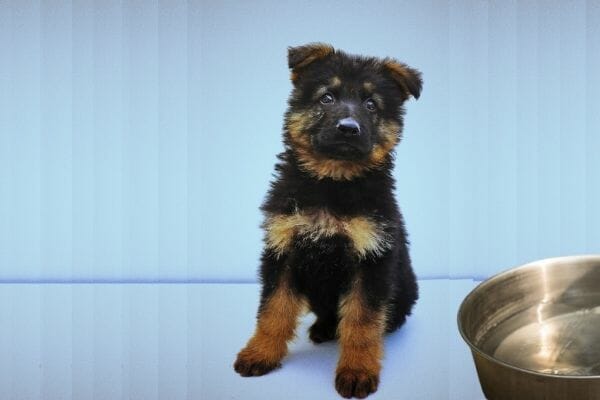
Now that we know what to look for in the best puppy food for German Shepherds and what to look for in the food itself, we need to take a closer look at how to feed a German Shepherd pup. We have broken down the important key factors to remember.
Feeding length
The feeding length refers to how long you give your pooch access to food. There are pet owners who adopt the free feeding method, which isn’t recommended for puppies as it is for adult dogs. Free feeding, or grazing, is when you leave the entire day’s worth of food out at once and allow your dog to go at his own pace. While this is okay for some dogs, it could breed some bad habits such as picky eating.
Picky eating can happen when a dog does not learn the scarcity of food, which means he will appreciate it less. When you feed your German Shepherd puppy food, we recommend giving him a 15 to 20 min window before removing it. This should be enough time for your pup to finish what’s in the bowl. On the other hand, there are German Shepherd pups that go the other way, the ones that inhale their food.
Eating too quickly could lead to stomach issues and bloating, so it is again a fine line to straddle. You want to give your dog enough time so he doesn’t feel rushed, but not too much time so he gets distracted by other things and forgets to eat. If your dog is the type to consume food too quickly, you can think about purchasing a slow feeder. A slow feeder will work for adult food as well. It’s a bowl that has protruding nubs that your dog needs to eat around to get to the food. Taking the extra time to do so will slow your dog down.
Feeding Frequency
Feeding frequency means how often you give your German Shepherd puppy food, or basically how many meals he gets a day. In general, puppies eat smaller meals more frequently. When your GSD pup switches to adult food, the frequency should also decrease. We are looking at anywhere around 3 or 4 meals a day. You would basically portion the entire day’s worth of food into 3 or 4 meals, and feed your pup every 3 to 4 hours.
This feeding frequency should continue until your large breed dogs are at least 6 months old, but we would recommend this until they hit a year. However, 6 months of age is when you can introduce foreign supplements and human foods such as chopped liver or cooked chicken breast to your dog’s meals as as well as toppings.
When your pooch gets to a year old, you can switch him to adult food.
Feeding Amount
Below is a German Shepherd puppy feeding chart guide to help you determine the right amount. Remember that consulting with a vet before trying anything new or drastically different is vital to your dog’s health.
Feeding Chart
| 3 months and below | 1/2 a cup |
| 3 months to 4 months | 1 to 1.5 cups |
| 6 months | 1.5 to 2 cups |
| 12 months (a year) | 1.5 to 3 cups |
Other Considerations When Feeding a German Shepherd Puppy
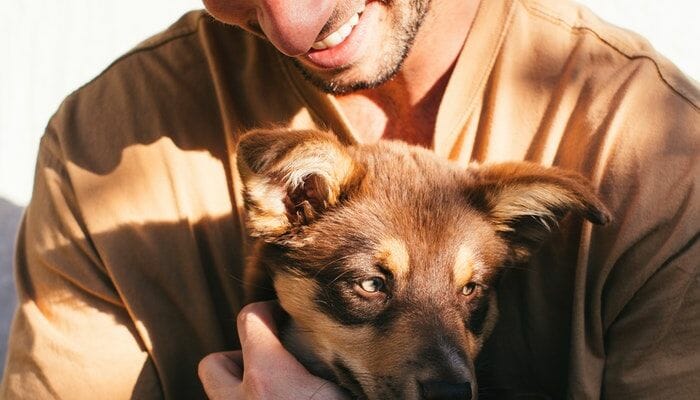
As we have mentioned above, how much exactly to feed a certain puppy will differ based on the below factors.
Age
As you can see from our feeding guidelines, the age is a key component in how much you feed your pup. Every couple of months should gain your pooch half a cup until he is old enough to enjoy adult food. Senior dogs will also notice a decrease in amount, because senior dogs don’t have as much energy to expend anymore, which means they will require less food.
A nursing mother may also need more food, as will a pregnant German Shepherd dog. Various key stages in your dog’s life will also affect how much you feed him.
Size
Male German Shepherds are larger than females, which means they will generally require more food. Larger GSDs will also need more food compared to the runt of the litter. You can always bring your large breed dog to the vet for a health check just to make sure he is growing according to schedule and to see if you are feeding him enough food.
Activity Level
The activity level will also influence your German Shepherd puppy feeding routine. A very active pup that’s always on the go will need more food than one that is naturally more relaxed. You should decide the portion size based on your dog’s activity level. You should feed a German Shepherd pup more if he is still hungry after the meal. Don’t worry, he will let you know if he is still hungry, so there shouldn’t be too much guesswork involved.
You don’t want to deprive your growing GSD pup of food especially when he’s still growing.
What Not to Do When Feeding a German Shepherd Puppy
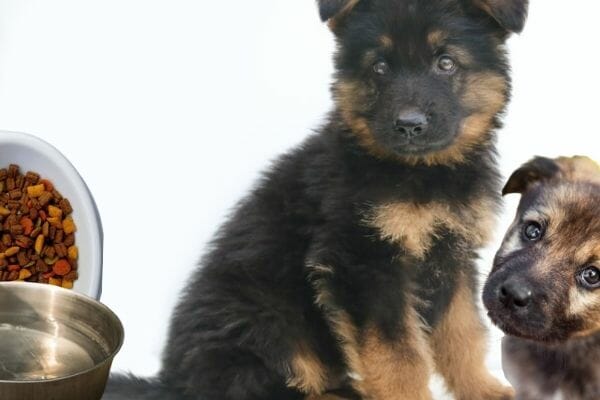
We know what to do, but there are also things a pet owner should avoid during German Shepherd puppy feeding.
Make Water Available
You should always make water accessible, but make sure to keep the water bowl full, especially if your dog has a lot of snacks or is mainly on a kibble diet. Doing so will help your dog avoid kidney failure in the future and other potential health issues.
Don’t Overfeed or Underfeed
As said, German Shepherd puppy feeding is a delicate balance. You don’t want to give him too much or too little in terms of amount or nutrition, and too much or too little time to finish.
No Drastic Changes
Do not switch kibble or add supplements and foreign ingredients too suddenly or by too much. Also, ask your vet if the extras you are thinking about adding are appropriate for your dog. As a large breed, your German Shepherd is more susceptible to elbow and hip dysplasia, which can be prevented with fish oil, glucosamine and chondroitin.
Know When to Switch
Just like you should know when to add things slowly and not switch diets too quickly, it’s also important to know when you should. If your dog just doesn’t like the flavor, the food isn’t suited to your dog, or the food has spoiled, definitely make the switch as soon as possible. Just remember to introduce the new food slowly.
Know What They Can’t Eat
It’s crucial to know what foods will benefit your dog, but it’s also vital to know what is harmful. There are plenty of human foods that dogs cannot eat. It’s important to get acquainted with this list, which includes items such as onions, grapes, chocolate, caffeine, certain nuts, and more.
Get the Right Size Kibble
German Shepherds are large dogs, which means they have big mouths. You can look into large breed-specific food, which has the appropriate-sized kibble. If the pieces are too small, your dog may swallow them too quickly or get a ton lodged in his teeth. If you are feeding a puppy kibble that’s too large, then it will be very difficult for him to chew.
Conclusion
We always spend a lot of time on food articles, because a dog’s diet is the most important aspect of his growth and health. A puppy’s diet, in particular, is even more important because it’s what your pooch consumes during his growing phase. When in doubt, you can always ask your vet. Remember to aim for a well-balanced diet no matter what type of dog food you choose, and to switch to the appropriate recipes during different life stages. Puppy, adult and senior German Shepherds have different needs.
Expert Tip
GSDs are a super active breed. Because of this shared trait, many of the GSD pups will eat a lot of food and need a lot of sustenance. This is why it’s so important to look for good puppy food.
Did You Know?
They are fiercely loyal, incredibly intelligent, and are the embodiment of “man’s best friend”, right up there with other herding and hunting dogs, service dogs, working dogs and companion pets such as Golden Retrievers and the Siberian Husky.

